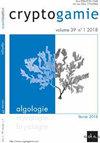Revision of the Genus Sirodotia Kylin (Batrachospermales, Rhodophyta) with Description of Four New Species
IF 1.5
4区 生物学
Q3 MARINE & FRESHWATER BIOLOGY
引用次数: 0
Abstract
ABSTRACT Most genera of the freshwater red algal order Batrachospermales have been systematically revised using molecular and morphological data, but Sirodotia Kylin remains to be thoroughly reviewed. In this investigation, DNA sequence data for the rbcL, COI-5P and LSU markers of specimens collected worldwide were combined with morphological observations to assess their specific diversity, infer their relationships and evaluate the morphological characters relevant for species identification. Phylogenetic analyses showed the genus to be a monophyletic lineage with high support. Inter- and intra-specific divergence values were well-delineated with higher interspecific (2.1-7% and 4.4-10.5%) and lower intraspecific (0-2.4% and 0-3.8%) variations for rbcL and COI-5P sequences, respectively. LSU sequences revealed lower interspecific divergence values than the COI-5P sequences (0.7-3.3%) indicating less resolution as a barcode marker. Nine species are recognized based on DNA sequence data, morphological characters and geographic distribution. Five species were previously described (S. assamica Necchi, Rossignolo, Yasmin, J.A.West & Ganesan, S. delicatula Skuja, S. huillensis (Welwitsch ex West & GSWest) Skuja, S. kennedyi A.L.Szinte, J.C.Taylor & M.L.Vis and S. suecica Kylin) and four new species are proposed (S. amazonica Necchi, N.L.Rossignolo & M.O.Paiano, sp. nov., S. aquiloamericana Necchi, N.L.Rossignolo & M.L.Vis, sp. nov., S. cryptica Necchi, N.L.Rossignolo & M.O.Paiano, sp. nov. and S. delicatuliformis Necchi, N.L.Rossignolo & M.O.Paiano, sp. nov.). Diagnostic characters for the genus are confirmed to be carpogonia asymmetric with a basal protuberance and carposporophytes diffuse with indeterminant prostrate filaments producing determinate erect branches terminating in carposporangia. The following morphological characters were applied to distinguish species: primary fascicle cell number, spermatangial arrangement, origin of gonimoblast filament and size of carposporangia. Based on morphology, S. sinica, S. segawae and S. yutakae are proposed as synonyms of S. suecica and S. ateleia Skuja of S. delicatula. The status of three species (S. cirrhosa Skuja ex M.S.Balakr. & B.B.Chaugule, S. gardneri Skuja ex Flint and S. huangshanensis Z.X.Shi & S.L.Xie) could not be confirmed due to lack of type specimens and published information on informative diagnostic characters.标题麒麟属(蝙蝠目雄性,红翅目)订正及四新种描述
淡水红藻目Batrachospermales的大多数属已经利用分子和形态学数据进行了系统的修订,但麒麟西罗多亚(Sirodotia Kylin)仍有待彻底的审查。本研究将世界各地标本rbcL、COI-5P和LSU标记的DNA序列数据与形态学观察相结合,评估它们的特异性多样性,推断它们之间的关系,并评价与物种鉴定相关的形态学特征。系统发育分析表明该属为单系谱系,支持度高。rbcL和COI-5P序列的种间和种内差异值较高(2.1-7%和4.4-10.5%),种内差异较低(0-2.4%和0-3.8%)。LSU序列的种间差异值低于COI-5P序列(0.7-3.3%),表明其作为条形码标记的分辨率较低。根据DNA序列数据、形态特征和地理分布鉴定出9种。5个新种(assamica Necchi, Rossignolo, Yasmin, J.A.West & Ganesan, S. delicatula Skuja, S. huillensis (Welwitsch ex West & GSWest) Skuja, S. kennedyi A.L.Szinte, j.c.t ell&m.l.vis和S. suecica Kylin), 4个新种(S. amazonica Necchi, N.L.Rossignolo & m.o.p iano, sp. 11), S. aquiloamericana Necchi, n.l.l Rossignolo & m.o.p iano, sp. 11), S. cryptica Necchi, n.l.l Rossignolo & m.o.p iano, sp. 11), S. delicatuliformis Necchi, n.l.l Rossignolo & m.o.p iano, sp. 11)。N.L.Rossignolo & M.O.Paiano, sp. 11)。本属的诊断特征为不对称的具基部突起的车孢子体和弥散的车孢子体,有不确定的匍匐花丝,产生确定的直立分支,终止于车孢子体。以初生束细胞数、精管排列方式、成性腺丝的来源和孢子囊的大小等形态学特征作为分种依据。从形态学上看,中国金丝桃、segawae和yutakae被认为是中国金丝桃(S. suecica)和中国金丝桃(S. ateleia Skuja)的近义词。三个物种的状况(S.肝硬化Skuja前M.S.Balakr。(b . b . chaugle, S. gardneri Skuja ex Flint, S. huangshanensis z.x.x shi & s.l.y xie)由于缺乏模式标本和已发表的信息诊断特征而无法得到证实。
本文章由计算机程序翻译,如有差异,请以英文原文为准。
求助全文
约1分钟内获得全文
求助全文
来源期刊

Cryptogamie Algologie
生物-海洋与淡水生物学
CiteScore
2.60
自引率
7.70%
发文量
11
审稿时长
>12 weeks
期刊介绍:
Cryptogamie is a fast-track and peer-reviewed journal of international scope publishing in English only. It accepts original papers and review articles on the taxonomy, biology and ecology of all cryptogams. An issue of Cryptogamie may be devoted to a single topic, under the responsibility of guest editor(s). All articles published in Cryptogamie are compliant with the different nomenclatural codes. A copyright assignment will be signed by the authors before publication.
Cryptogamie, Algologie accepts articles on systematics as well as ecology and evolution of any kind of algae (including Cyanobacteria).
 求助内容:
求助内容: 应助结果提醒方式:
应助结果提醒方式:


